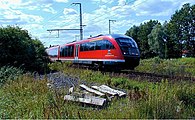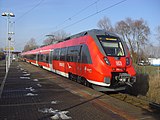Rostock S-Bahn
| Rostock S-Bahn |
|||||||||||||||||||||||||
|
|||||||||||||||||||||||||
The Rostock S-Bahn is a S-Bahn in the Mecklenburg Hanseatic city of Rostock . It consists of three lines with a total length of around 90 km. The S1 line from the main train station to Warnemünde runs within the Rostock urban area. S-Bahn operations began there as early as the 1970s. Later, the lines to the seaport and the southern city of Güstrow via Schwaan were included in the S-Bahn network. In 2012 the line to the seaport was discontinued, but the connection to Güstrow via Laage has been part of the Rostock S-Bahn as line S3 since then . Until 2014, push- pull trains with double-deck cars were mainly used. Since then, new Talent 2 railcars have been running on all lines .
Lines
course
To the west of the Unterwarnow , the S1 line runs from Warnemünde via the new development areas Lichtenhagen , Lütten Klein , Evershagen and through the industrial areas Marienehe and Bramow between the Kröpeliner-Tor-Vorstadt and the Hansaviertel to Rostock Central Station , which is located in the south of the Steintor-Vorstadt (course book route 181).
The S2 also begins in Warnemünde, follows the route of the S1 line, but goes beyond the main station to the southern outskirts of Rostock. It crosses the Warnow at Schwaan and continues to Güstrow (course book route 182).
The S3 also begins in Warnemünde and follows the route of the Lloydbahn in a southerly direction via Laage (Meckl) and the connecting line Plaaz - Priemerburg to the city of Güstrow.
Stations and travel times
| line | Hold | Length in km | Travel time in min. | route |
|---|---|---|---|---|
|
|
10 | 13.3 | 20th | Warnemünde - Warnemünde Werft - R.-Lichtenhagen - R.-Lütten Klein - R.-Evershagen - R.-Marienehe - R.-Bramow - R. Holbeinplatz - R. Parkstraße - Rostock Hauptbahnhof (main line only) |
|
|
17th | 47.6 | 58 | Warnemünde - (like S1) - Rostock main station - Papendorf - Pölchow - Huckstorf - Schwaan - Mistorf - Lüssow - Güstrow |
|
|
18th | 58.1 | 74 | Warnemünde - (like S1) - Rostock main station - Kavelstorf - Scharstorf - Kronskamp - Laage - Subzin-Liessow - Plaaz - Priemerburg - Güstrow |
history
On the route between Rostock main train station and the seaside resort of Warnemünde there has long been heavy suburban traffic. In terms of tariffs, he had already benefited from inexpensive day return tickets since 1923.
The cancellation of these offers led to protests by the Warnow shipyard workers in 1953, so that a few weeks later the previous prices came into force again. With the construction of new housing estates along this route that began in the 1960s, the importance of this relationship grew.
The existing route via Schmarl was on the one hand too far away for the oldest and largest of these new development areas, Lütten Klein , on the other hand, further new development areas were planned on the route. In the 1960s, a route west of the city motorway to Warnemünde was initially considered, but due to the high construction costs, these plans were not pursued. Instead, the construction of a route next to the city motorway on the east side began in 1968. First, on July 12, 1970, a branch line from Bramow to Lütten Klein was opened to connect the residential area with the city center and the port area. From Bramow to Evershagen the track was next to the main track to Warnemünde in the location of the former second track. On this day, based on the tariffs of other light rail vehicles, tariff simplifications came into force. A trip from Rostock to Warnemünde cost a standard 50 pfennigs, for shorter distances you paid the normal tariff of the Deutsche Reichsbahn.
The line to Lütten Klein was extended to the north in the following years and reintroduced into the old line south of the Warnemünde shipyard stop. With the completion of this new line, the official start of the S-Bahn (today's S1 line) took place in 1974 and the previously irregular traffic was synchronized. The old line via Schmarl station was closed.
On December 14, 1985, electrical operations began on the Rostock S-Bahn. In rush -hour traffic, push-pull trains made up of three four-part double-decker units were hauled by the 118 series until electrification , then with the 243 series (now 143).
The route to Rostock's overseas port was not considered an S-Bahn at the time, even if all trips to and from Warnemünde were connected. It was not until 1987 that the S-Bahn tariff to the overseas port was introduced. The official name "S-Bahn" for trains to the seaport was only introduced in 1988.
From 1982 onwards, several S-Bahn trains ran from Warnemünde to Rostock on to the fertilizer plant in Poppendorf . These trains were considered pure commuter trains and were not in the public timetables for the section east of Rostock. In 1992 these trains stopped operating.
After the reunification in the GDR , the volume of rush hour traffic decreased in the 1990s, as not only did most of the large companies cut their staff or were closed completely, but also the residential areas along the S-Bahn routes lost residents. The train lengths were gradually reduced to three double-decker coaches. In 2002 the 7½ minute intervals in rush hour traffic were thinned to 10 minutes.
Also since the 1990s, the local trains from Güstrow to Rostock have been called the S-Bahn and run continuously to Warnemünde.
Planning with the aim of the S-Bahn system Rostock with tram of the city to a light rail system to link were abandoned in of 2007.
In 2009, the state of Mecklenburg-Western Pomerania announced the operation on the sub-network "Warnow", which includes the Rostock S-Bahn and the Wismar –Rostock– Ticino , ( Bad Doberan -) Rostock– Graal-Müritz and Wismar – Ludwigslust lines belong. DB Regio Nordost won the tender and remained the operator of the Rostock S-Bahn and will also take over the Rostock – Laage – Güstrow line until 2024. From the 2012 timetable change, this line was added to the S-Bahn network and run as S3. Trains between Rostock and Warnemünde run every 7½ minutes during rush hour and every 15 minutes during off-peak hours, every 60 minutes on the other sections from Monday to Friday, and only every 2 hours on weekends.
In mid-May 2012, the Mecklenburg-Western Pomerania Ministry of Energy, Infrastructure and Regional Development announced that the future S4 line to the Rostock seaport should not be introduced. The Rostock city administration objected to this, and they spoke out in favor of an extension of the S-Bahn to the ferry terminal in the overseas port . However, on December 9, 2012, passenger traffic to the seaport was completely canceled. The stop in Mierendorf (near Güstrow) is also no longer served.
From December 2012, all lines were to be operated with brand-new, five-part Bombardier Talent 2 electric multiple units , which should replace the old double-decker push-pull trains (S1 and S2) and diesel multiple units (S3). These trains were not yet available at the 2012 timetable change. The old trains continued to run on lines S1 and S2, line S3 was divided into two parts in Rostock (Warnemünde – Rostock Hbf and Rostock Hbf – Laage – Güstrow), locomotive-hauled trains with newer double-deck coaches ran between Rostock and Güstrow.
Since April 26, 2014, all Talent 2 multiple units have been available for the S-Bahn and have completely replaced the locomotive-hauled trains.
expansion
The Rostock 2017 mobility plan contains several measures for the S-Bahn. In the medium term, two new stops are to be set up on the Rostock – Warnemünde route. One of them would be in the Groß Klein district near the Schiffbauerring, another in the Schmarl district near the Schmarler Bach and the Stephan-Jantzen-Ring. Also in the medium term, according to the ideas of the city of Rostock, another S-Bahn line should run to the Rostock seaport. A new end stop is to be created in the direct vicinity of the ferry terminal.
Vehicle use
For a long time, double-decker push-pull trains ran between Rostock and Warnemünde . In addition, trains made up of two four-part DR double-decker trains (but no articulated trains) were used, and in rush hour traffic since the mid-1970s even partly made up of three parts with a total of twelve cars. In the 1980s, the four-part double-decker trains were replaced by double-decker single wagons, which were still in use in 2013 after being modernized in the 1990s.
Locomotive-hauled trains with the class 143 , two modernized double-decker cars of the Reichsbahn design and a new double-decker control car ran on all lines . On special occasions, the trains could be extended to a maximum length of five cars (control car, four intermediate cars). All trains had first and second carriage classes. The cars were marked with the lettering "S-Bahn Rostock DB".
As of October 9, 2013, starting on the route from Rostock via Laage to Güstrow, all 23 Talent-2 railcars ordered have gradually replaced the old double-decker trains. The changeover was completed on April 26, 2014. Since then, only the Talent 2 railcars have been running in the entire network. Class 143 locomotives with only two double-deck cars are now only used as replacements.
Car of the Rostock S-Bahn for temporary help in Berlin Alexanderplatz
Class 642 multiple unit on the route from Rostock seaport
literature
- Lothar Schultz, Josef Temmen: The Rostock – Warnemünde S-Bahn . Kenning, Nordhorn 2004, ISBN 3-933613-69-8 .
Web links
Individual evidence
- ↑ Hans Schweers, Heninng Wall, Thomas Worthy: Railway Atlas Germany . 8th edition. Schweers + Wall, 2011, ISBN 978-3-89494-140-6 .
- ↑ a b c Lothar Schultz, Josef Temmen: Die S-Bahn Rostock - Warnemünde , Verlag Kenning 2004, ISBN 3-933613-69-8 , pp. 28/29
- ^ Lothar Schultz, Josef Temmen: Die S-Bahn Rostock - Warnemünde , Verlag Kenning 2004, ISBN 3-933613-69-8 , p. 13
- ^ Deutsche Reichsbahn, Kursbuch 1987/88 and Kursbuch 1988/89
- ↑ Sub-network Warnow advertised - Schlotmann: Quality should get better. In: Government portal MV. Ministry of Energy, Infrastructure and Regional Development, October 29, 2009, accessed on November 23, 2018 .
- ↑ Warnow sub-network is assigned to DB Regio - Schlotmann: New railcars, more trains. In: Government portal MV. Ministry of Energy, Infrastructure and Regional Development, June 30, 2010, accessed on November 23, 2018 .
- ^ Schlotmann is also canceling in Rostock , Warnow-Kurier, April 5, 2012
- ↑ Verkehrsverbund Warnow, VVW timetable booklet 2012/2013, page 3
- ↑ Press release 104/2010. (No longer available online.) Deutsche Bahn, formerly in the original ; accessed on November 23, 2018 . ( Page no longer available , search in web archives )
- ↑ Future mobility plan - general report. (PDF) p. 115 , accessed on November 23, 2018 .
- ↑ Future mobility plan - general report. (PDF) p. 114 , accessed on November 23, 2018 .
- ↑ farewell to the Rostock 143zigern. In: eisenbahnen-in-mv.de. Retrieved November 23, 2018 .












